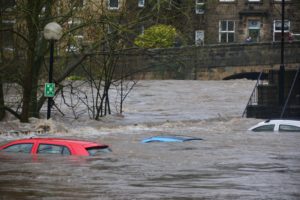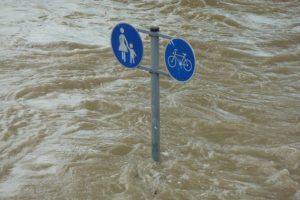Flooding is an increasing hazard for homeowners. And the bad news is that it doesn’t just strike the highest flood-risk areas.
According to the Federal Emergency Management Agency (FEMA), even people living in low and moderate flood-risk areas are five times more likely to experience a flood than a fire at home.
And, whether you believe in climate change or not, the fact is that our weather here in Maine seems to be more unpredictable than ever. 
Heavy rainfall, fast or excessive snow-melt, ice-jams, rising sea levels and unexpected storm surges, all represent a potential flooding threat. In the past couple of years, we’ve seen evidence of its potential such as the flooding of the municipal parking lot in 2018.
Sometimes, even weather forecasting services can get things wrong so you can’t always be sure if or when flooding will hit.
However, there are a number of useful things you can do to prepare yourself for floods and limit the potential effects of a sudden inundation.
What Is The Risk of Flooding in My Area?
Although it’s only a guide, it’s important to know what the general flood risk is for your area. These are based on assessments made on past floods, geography, and climate trends.
Although some parts of Damariscotta and Newcastle are considered to be low risk, certain areas, particularly along the waters’ edge, are considered more vulnerable. In fact Damariscotta is considered the most at risk town in Lincoln County.
Sea Grant at the University of Maine has warned of a potential flooding level of five feet above the harbor parking lot, putting at risk portions of Main Street, as well as ground floors and basements elsewhere.
And a Lincoln County Coastal Hazard Study says there’s clear evidence that the sea level has increased in mid-coast Maine over the past 100 years, and that the rise is now happening faster.
Which Flood Zone am I In?
FEMA oversees the production of flood zone maps. You can do a map search based on your address here: https://msc.fema.gov/portal/search
Tips For Avoiding and Dealing With Flooding
Our town is actively tackling the issue of flood resiliency, so hopefully, we will see some additional council- and state-mandated protection added in the coming years. But there also important protection and response steps you can take.
What you do depends on whether a flood is impending or whether you want to protect your home against longer-term, future risks. 
Based on expert advice from emergency services experts, here are top tips on how to avoid flooding and what to do if it happens.
- Be in the know. Sign-up to be notified of a flood alert. There are many different ways of doing this. For instance, you can sign up to receive alerts from the Maine Emergency Management Agency (https://www.maine.gov/MEMA/weather/watch_warn.shtml) or the Advanced Hydrologic Prediction Service (https://water.weather.gov/ahps2/). Several popular weather apps like AccuWeather and wunderground will also send alerts if you sign up.
It’s important to know the difference between a flood warning and a flood watch alert. The warning means you need to take action and move to higher ground. A flood watch means flooding is possible but not certain and that you should be prepared to take action. - Prepare Your Home for a Flood.
- If the flood is not imminent, consider having your electrical outlets raised to at least one foot above possible water levels.
- Install check-valves to stop flood water from backing up into drains.
- If you have a sump pump, have it checked and make sure it’s working.
- Make sure your circuit breakers or fuses are clearly marked for each area of your home. If water rises, shut off electricity altogether
- Move appliances, perishable goods, and other vulnerable items to a high point like a raised floor, an attic or second story. Large appliances can be lifted onto concrete blocks.
- Assemble an emergency kit with enough food, water, and medicine on hand to last for 3 days. Keep this replenished at all times.
- Prepare Outside
- If the flood is not imminent, consider relocating generators, air conditioning units, and fuel tanks to higher levels.
- Check (and, if necessary clear) drains, guttering and downspouts.
- Clear or install foundation vents that will allow water to flow through the building rather than rising around it.
- Ensure earth, planting beds and driveways slope away from your building structure.
- Keep a small store of sandbags or ensure you have easy access to some. They can hold a low flood at bay.
- Move your car to higher ground.
- Create an escape and communication plan. Have you discussed or even thought about what you would do if a flood strikes? Now’s the time to do that. Ensure you’re ready to leave if trouble strikes, know where you’ll go and stay, and keep a list of people you will need to contact if your home is flooded and you evacuate.
Don’t forget to include any pets you have in your plan. - If you’re told to evacuate, do it. If you have time, switch off and disconnect appliances and utilities.
If possible, don’t take risks by trying to walk or drive through flooded areas. Only 12 inches of flooding is enough to sweep you off your feet or float or damage a car. Stay out of water that may have electricity in it.
Do I Need Flood Insurance?
There are very few people who we would advise against flood insurance. In Maine, it’s not as expensive as some other areas of the nation — and it provides you with peace of mind that if the worst happens, you’ll have enough money to put things right.
peace of mind that if the worst happens, you’ll have enough money to put things right.
The best time to do this is now. Most policies don’t activate until at least 30 days after they’re purchased, so waiting until you receive a storm or flood warning may not provide the protection you need. There are Government-sponsored and private insurance programs.
If you’d like to know more about this, please contact the team here at Cheney Insurance. We can advise on your flood zone, levels of coverage, deductibles and more.
Of course, we hope your future is dry — but we’re also here for the rainy days.
